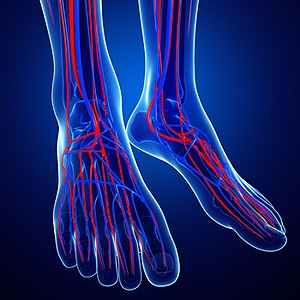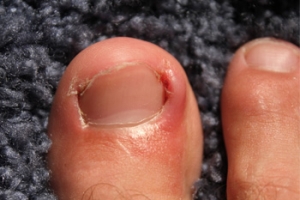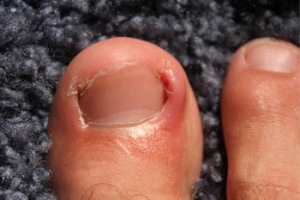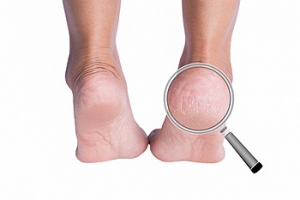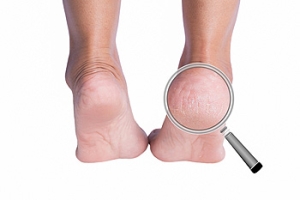Items filtered by date: October 2019
Can Existing Medical Conditions Cause Poor Circulation?
A common cause of poor circulation is a medical condition known as peripheral artery disease, otherwise known as PAD. If this develops, the arteries and blood vessels in the legs may become narrow, and it may contribute to decreased blood flow to the legs. Some of the symptoms linked with this ailment can include nerve and tissue damage, and patients may feel tingling and numbing sensations. Research has indicated that there are a variety of reasons why poor circulation may develop. These can include medical conditions such as diabetes, Raynaud’s disease, and obesity may play a significant role in developing poor circulation. Some patients may benefit from wearing compression socks in addition to frequently elevating their feet. This may help to reduce any existing swelling. If you suffer from poor circulation, it is advised that you seek the counsel of a podiatrist who can guide you toward proper treatment options.
Poor circulation is a serious condition and needs immediate medical attention. If you have any concerns with poor circulation in your feet contact Dr. Kenneth Donovan of Advanced Care Foot and Ankle. Our doctor will treat your foot and ankle needs.
Poor Circulation in the Feet
Poor blood circulation in the feet and legs is can be caused by peripheral artery disease (PAD), which is the result of a buildup of plaque in the arteries.
Plaque buildup or atherosclerosis results from excess calcium and cholesterol in the bloodstream. This can restrict the amount of blood which can flow through the arteries. Poor blood circulation in the feet and legs are sometimes caused by inflammation in the blood vessels, known as vasculitis.
Causes
Lack of oxygen and oxygen from poor blood circulation restricts muscle growth and development. It can also cause:
- Muscle pain, stiffness, or weakness
- Numbness or cramping in the legs
- Skin discoloration
- Slower nail & hair growth
- Erectile dysfunction
Those who have diabetes or smoke are at greatest risk for poor circulation, as are those who are over 50. If you have poor circulation in the feet and legs it may be caused by PAD and is important to make changes to your lifestyle in order to reduce risk of getting a heart attack or stroke. Exercise and maintaining a healthy lifestyle will dramatically improve conditions.
As always, see a podiatrist as he or she will assist in finding a regimen that suits you. A podiatrist can also prescribe you any needed medication.
If you have any questions please feel free to contact one of our offices located in Warren, Livingston, and Toms River, NJ . We offer the newest diagnostic and treatment technologies for all your foot and ankle needs.
Why Do Ingrown Toenails Develop?
When a toenail grows into the skin instead of over it, it’s referred to as an ingrown toenail. Ingrown toenails generally cause severe pain and discomfort, and shoes may become difficult to wear. Some associated symptoms include pus draining from the sides of the nail and the surrounding skin turning red and swollen. Common reasons why ingrown toenails develop include trimming the toenail incorrectly, wearing shoes and socks that are too tight, or an injury that has occurred to the toe. Patients who have this ailment may find moderate relief when the toe is soaked in warm water. This helps soften the skin around the nail. If the area becomes infected, seek the counsel of a podiatrist who can properly treat ingrown toenails.
Ingrown toenails may initially present themselves as a minor discomfort, but they may progress into an infection in the skin without proper treatment. For more information about ingrown toenails, contact Dr. Kenneth Donovan of Advanced Care Foot and Ankle. Our doctor can provide the care you need to keep you pain-free and on your feet.
Ingrown Toenails
Ingrown toenails are caused when the corner or side of a toenail grows into the soft flesh surrounding it. They often result in redness, swelling, pain, and in some cases, infection. This condition typically affects the big toe and may recur if it is not treated properly.
Causes
- Improper toenail trimming
- Genetics
- Improper shoe fitting
- Injury from pedicures or nail picking
- Abnormal gait
- Poor hygiene
You are more likely to develop an ingrown toenail if you are obese, have diabetes, arthritis, or have any fungal infection in your nails. Additionally, people who have foot or toe deformities are at a higher risk of developing an ingrown toenail.
Symptoms
Some symptoms of ingrown toenails are redness, swelling, and pain. In rare cases, there may be a yellowish drainage coming from the nail.
Treatment
Ignoring an ingrown toenail can have serious complications. Infections of the nail border can progress to a deeper soft-tissue infection, which can then turn into a bone infection. You should always speak with your podiatrist if you suspect you have an ingrown toenail, especially if you have diabetes or poor circulation.
If you have any questions, please feel free to contact one of our offices located in Warren, Livingston, and Toms River, NJ . We offer the newest diagnostic and treatment technologies for all your foot care needs.
Why Do Ingrown Toenails Develop?
When a toenail grows into the skin instead of over it, it’s referred to as an ingrown toenail. Ingrown toenails generally cause severe pain and discomfort, and shoes may become difficult to wear. Some associated symptoms include pus draining from the sides of the nail and the surrounding skin turning red and swollen. Common reasons why ingrown toenails develop include trimming the toenail incorrectly, wearing shoes and socks that are too tight, or an injury that has occurred to the toe. Patients who have this ailment may find moderate relief when the toe is soaked in warm water. This helps soften the skin around the nail. If the area becomes infected, seek the counsel of a podiatrist who can properly treat ingrown toenails.
Ingrown toenails may initially present themselves as a minor discomfort, but they may progress into an infection in the skin without proper treatment. For more information about ingrown toenails, contact Dr. Kenneth Donovan of Advanced Care Foot and Ankle. Our doctor can provide the care you need to keep you pain-free and on your feet.
Ingrown Toenails
Ingrown toenails are caused when the corner or side of a toenail grows into the soft flesh surrounding it. They often result in redness, swelling, pain, and in some cases, infection. This condition typically affects the big toe and may recur if it is not treated properly.
Causes
- Improper toenail trimming
- Genetics
- Improper shoe fitting
- Injury from pedicures or nail picking
- Abnormal gait
- Poor hygiene
You are more likely to develop an ingrown toenail if you are obese, have diabetes, arthritis, or have any fungal infection in your nails. Additionally, people who have foot or toe deformities are at a higher risk of developing an ingrown toenail.
Symptoms
Some symptoms of ingrown toenails are redness, swelling, and pain. In rare cases, there may be a yellowish drainage coming from the nail.
Treatment
Ignoring an ingrown toenail can have serious complications. Infections of the nail border can progress to a deeper soft-tissue infection, which can then turn into a bone infection. You should always speak with your podiatrist if you suspect you have an ingrown toenail, especially if you have diabetes or poor circulation.
If you have any questions, please feel free to contact one of our offices located in Warren, Livingston, and Toms River, NJ . We offer the newest diagnostic and treatment technologies for all your foot care needs.
Heel Pain Can Be Treated!
Do you suffer from heel pain when you get up in the morning? If so, you should seek the professional help of your podiatrist and have a proper diagnosis performed. Heel pain can be caused by several different foot-related conditions.
Causes Of Cracked Heels
Patients who have cracked heels are often familiar with the pain and discomfort this condition may cause. Fissures are deep cracks in the skin that develop on the outer edge of the heels and may occur due to a variety of reasons. Common causes can include wearing shoes that have an open back and standing for extended periods of time throughout the day. Additionally, obesity may play a significant role in the development of cracked heels. Fortunately, there are measures that may help prevent this condition. These can include limiting the time standing, avoiding vitamin deficiencies, and wearing shoes that have ample cushioning in the heel area. If you are experiencing this ailment, speak to a podiatrist who can provide you with proper treatment techniques.
Cracked heels are unsightly and can cause further damage to your shoes and feet. If you have any concerns, contact Dr. Kenneth Donovan from Advanced Care Foot and Ankle. Our doctor can provide the care you need to keep you pain-free and on your feet.
Cracked Heels
Cracked heels appear unappealing and can make it harder for you walk around in sandals. Aside from looking unpleasant, cracked heels can also tear stockings, socks, and wear out your shoes. There are several methods to help restore a cracked heel and prevent further damage.
How Do You Get Them?
Dry skin is the number one culprit in creating cracked heels. Many athletes, walkers, joggers, and even swimmers suffer from cracked heels. Age and skin oil production play a role to getting cracked heels as well.
Promote Healing
Over the counter medicines can help, especially for those that need instant relief or who suffer from chronic dry feet.
Wear Socks – Wearing socks with medicated creams helps lock in moisture.
Moisturizers – Applying both day and night will help alleviate dryness which causes cracking.
Pumice Stones – These exfoliate and remove dead skin, which allows for smoother moisturizer application and better absorption into the skin.
Eating healthy with a well-balanced diet will give the skin a fresh and radiant look. Your body responds to the kinds of food you ingest. Omega-3 fatty acids and zinc supplements can also revitalize skin tissue.
Most importantly, seek professional help if unsure how to proceed in treating cracked heels.
If you have any questions, please feel free to contact one of our offices located in Warren, Livingston, and Toms River, NJ . We offer the newest diagnostic and treatment technologies for all your foot care needs.
Causes Of Cracked Heels
 Patients who have cracked heels are often familiar with the pain and discomfort this condition may cause. Fissures are deep cracks in the skin that develop on the outer edge of the heels and may occur due to a variety of reasons. Common causes can include wearing shoes that have an open back and standing for extended periods of time throughout the day. Additionally, obesity may play a significant role in the development of cracked heels. Fortunately, there are measures that may help prevent this condition. These can include limiting the time standing, avoiding vitamin deficiencies, and wearing shoes that have ample cushioning in the heel area. If you are experiencing this ailment, speak to a podiatrist who can provide you with proper treatment techniques.
Patients who have cracked heels are often familiar with the pain and discomfort this condition may cause. Fissures are deep cracks in the skin that develop on the outer edge of the heels and may occur due to a variety of reasons. Common causes can include wearing shoes that have an open back and standing for extended periods of time throughout the day. Additionally, obesity may play a significant role in the development of cracked heels. Fortunately, there are measures that may help prevent this condition. These can include limiting the time standing, avoiding vitamin deficiencies, and wearing shoes that have ample cushioning in the heel area. If you are experiencing this ailment, speak to a podiatrist who can provide you with proper treatment techniques.
Cracked heels are unsightly and can cause further damage to your shoes and feet. If you have any concerns, contact Dr. Kenneth Donovan from Advanced Care Foot and Ankle. Our doctor can provide the care you need to keep you pain-free and on your feet.
Cracked Heels
Cracked heels appear unappealing and can make it harder for you walk around in sandals. Aside from looking unpleasant, cracked heels can also tear stockings, socks, and wear out your shoes. There are several methods to help restore a cracked heel and prevent further damage.
How Do You Get Them?
Dry skin is the number one culprit in creating cracked heels. Many athletes, walkers, joggers, and even swimmers suffer from cracked heels. Age and skin oil production play a role to getting cracked heels as well.
Promote Healing
Over the counter medicines can help, especially for those that need instant relief or who suffer from chronic dry feet.
Wear Socks – Wearing socks with medicated creams helps lock in moisture.
Moisturizers – Applying both day and night will help alleviate dryness which causes cracking.
Pumice Stones – These exfoliate and remove dead skin, which allows for smoother moisturizer application and better absorption into the skin.
Change in Diet
Eating healthy with a well-balanced diet will give the skin a fresh and radiant look. Your body responds to the kinds of food you ingest. Omega-3 fatty acids and zinc supplements can also revitalize skin tissue.
Most importantly, seek professional help if unsure how to proceed in treating cracked heels. A podiatrist will help you with any questions or information needed.
If you have any questions, please feel free to contact one of our offices located in Warren, Livingston, and Toms River, NJ . We offer the newest diagnostic and treatment technologies for all your foot care needs.
